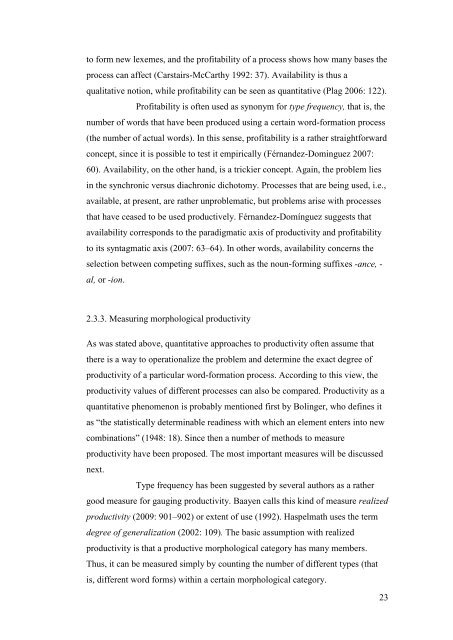The morphological productivity of selected ... - Helda - Helsinki.fi
The morphological productivity of selected ... - Helda - Helsinki.fi
The morphological productivity of selected ... - Helda - Helsinki.fi
You also want an ePaper? Increase the reach of your titles
YUMPU automatically turns print PDFs into web optimized ePapers that Google loves.
to form new lexemes, and the pr<strong>of</strong>itability <strong>of</strong> a process shows how many bases the<br />
process can affect (Carstairs-McCarthy 1992: 37). Availability is thus a<br />
qualitative notion, while pr<strong>of</strong>itability can be seen as quantitative (Plag 2006: 122).<br />
Pr<strong>of</strong>itability is <strong>of</strong>ten used as synonym for type frequency, that is, the<br />
number <strong>of</strong> words that have been produced using a certain word-formation process<br />
(the number <strong>of</strong> actual words). In this sense, pr<strong>of</strong>itability is a rather straightforward<br />
concept, since it is possible to test it empirically (Férnandez-Dominguez 2007:<br />
60). Availability, on the other hand, is a trickier concept. Again, the problem lies<br />
in the synchronic versus diachronic dichotomy. Processes that are being used, i.e.,<br />
available, at present, are rather unproblematic, but problems arise with processes<br />
that have ceased to be used productively. Férnandez-Domínguez suggests that<br />
availability corresponds to the paradigmatic axis <strong>of</strong> <strong>productivity</strong> and pr<strong>of</strong>itability<br />
to its syntagmatic axis (2007: 63–64). In other words, availability concerns the<br />
selection between competing suf<strong>fi</strong>xes, such as the noun-forming suf<strong>fi</strong>xes -ance, -<br />
al, or -ion.<br />
2.3.3. Measuring <strong>morphological</strong> <strong>productivity</strong><br />
As was stated above, quantitative approaches to <strong>productivity</strong> <strong>of</strong>ten assume that<br />
there is a way to operationalize the problem and determine the exact degree <strong>of</strong><br />
<strong>productivity</strong> <strong>of</strong> a particular word-formation process. According to this view, the<br />
<strong>productivity</strong> values <strong>of</strong> different processes can also be compared. Productivity as a<br />
quantitative phenomenon is probably mentioned <strong>fi</strong>rst by Bolinger, who de<strong>fi</strong>nes it<br />
as “the statistically determinable readiness with which an element enters into new<br />
combinations” (1948: 18). Since then a number <strong>of</strong> methods to measure<br />
<strong>productivity</strong> have been proposed. <strong>The</strong> most important measures will be discussed<br />
next.<br />
Type frequency has been suggested by several authors as a rather<br />
good measure for gauging <strong>productivity</strong>. Baayen calls this kind <strong>of</strong> measure realized<br />
<strong>productivity</strong> (2009: 901–902) or extent <strong>of</strong> use (1992). Haspelmath uses the term<br />
degree <strong>of</strong> generalization (2002: 109). <strong>The</strong> basic assumption with realized<br />
<strong>productivity</strong> is that a productive <strong>morphological</strong> category has many members.<br />
Thus, it can be measured simply by counting the number <strong>of</strong> different types (that<br />
is, different word forms) within a certain <strong>morphological</strong> category.<br />
23
















